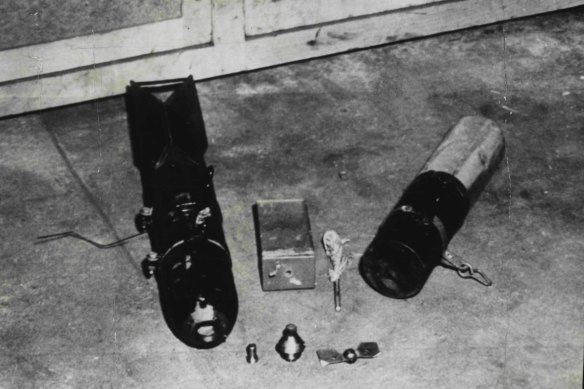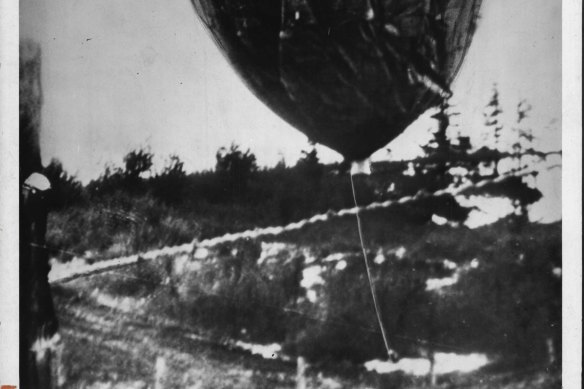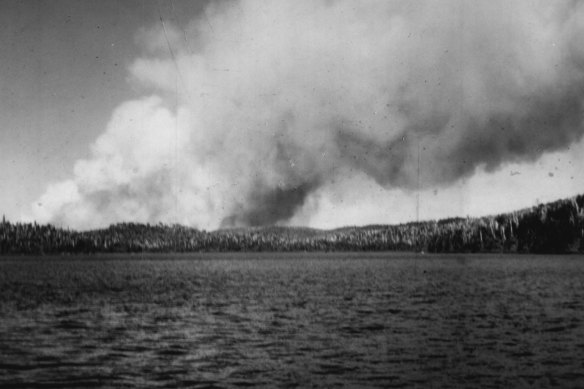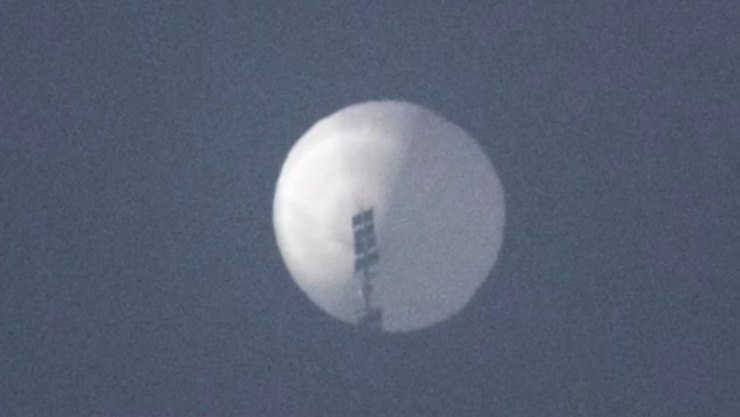By Kathryn Tolbert
February 4, 2023 —
A menacing balloon from Asia floated in the skies over Montana. The year was 1944.
The balloon, with a small incendiary bomb attached, drifted down to a forested area near Kalispell, Montana, crumpling into a heap. Two loggers found it there in December that year.

A Japanese balloon-borne bomb that fell in western Canada in 1945.
CREDIT:AP WIREPHOTO
The FBI and Army Air Force arrived to study the strange contraption, about 10 metres wide, made of laminated paper. Writing on the balloon told them it was Japanese and had been completed a few weeks earlier at a Japanese factory.
Around the same time, a bomb crater was discovered near Thermopolis, Wyoming. And then another balloon was found near Estacada, Oregon.
Farmers, ranchers and others began reporting balloon incidents. They heard explosions or found small holes in the ground with metal fragments nearby, or partially inflated balloons in the scrub brush.
What they were seeing was Japan’s effort to bring the war to the United States mainland by launching bomb-bearing balloons onto the Pacific jet stream. Japan launched nearly 10,000 such balloons from Nov. 3, 1944, to April 1945. About 300 of them landed in the United States. Each carried two incendiaries and a 15 kilogram antipersonnel bomb.
The FBI and Army Air Force arrived to study the strange contraption, about 10 metres wide, made of laminated paper. Writing on the balloon told them it was Japanese and had been completed a few weeks earlier at a Japanese factory.
Around the same time, a bomb crater was discovered near Thermopolis, Wyoming. And then another balloon was found near Estacada, Oregon.
Farmers, ranchers and others began reporting balloon incidents. They heard explosions or found small holes in the ground with metal fragments nearby, or partially inflated balloons in the scrub brush.
What they were seeing was Japan’s effort to bring the war to the United States mainland by launching bomb-bearing balloons onto the Pacific jet stream. Japan launched nearly 10,000 such balloons from Nov. 3, 1944, to April 1945. About 300 of them landed in the United States. Each carried two incendiaries and a 15 kilogram antipersonnel bomb.

One of Japan’s “paper ICBMs” landing near the United States-Canada border in March 1945.
CREDIT:CANADA WIDE PHOTO
“It’s the only thing that they had that was capable of reaching the United States – and even that was a long shot,” Robert Mikesh, who wrote a monograph about Japan’s balloon bomb program for the Smithsonian Annals of Flight Series, said in a 2020 interview.
The only casualties from those attacks came from the tragic discovery on May 5, 1945, of an unexploded balloon bomb by small group on a church outing in the Gearhart Mountain area of Southern Oregon. The Rev. Archie Mitchell and his wife, Elsie Mitchell, of Bly, took five children with them. While the reverend parked the car, Elsie and the children called to him that they had found a strange object in the woods. He shouted a warning, but it was too late. The explosion killed his wife and the five children, ages 11 to 14.
The U.S. Office of Censorship had asked journalists not to report on the balloon bomb incidents so that the Japanese would not know they had successfully reached the U.S. mainland, and the request was honoured. But after the deaths in Oregon, the War Department issued a statement describing the balloon bombs so that people finding debris would know not to touch it.
By then, Japan had stopped launching balloons, though they continued to be found in and over the United States through the summer. Because of the news blackout, the Japanese did not know the results of the balloon attacks.

Japan hoped its balloon bombs would ignite fires.
“It’s the only thing that they had that was capable of reaching the United States – and even that was a long shot,” Robert Mikesh, who wrote a monograph about Japan’s balloon bomb program for the Smithsonian Annals of Flight Series, said in a 2020 interview.
The only casualties from those attacks came from the tragic discovery on May 5, 1945, of an unexploded balloon bomb by small group on a church outing in the Gearhart Mountain area of Southern Oregon. The Rev. Archie Mitchell and his wife, Elsie Mitchell, of Bly, took five children with them. While the reverend parked the car, Elsie and the children called to him that they had found a strange object in the woods. He shouted a warning, but it was too late. The explosion killed his wife and the five children, ages 11 to 14.
The U.S. Office of Censorship had asked journalists not to report on the balloon bomb incidents so that the Japanese would not know they had successfully reached the U.S. mainland, and the request was honoured. But after the deaths in Oregon, the War Department issued a statement describing the balloon bombs so that people finding debris would know not to touch it.
By then, Japan had stopped launching balloons, though they continued to be found in and over the United States through the summer. Because of the news blackout, the Japanese did not know the results of the balloon attacks.

Japan hoped its balloon bombs would ignite fires.
CREDIT:CANADA WIDE PHOTO
Mikesh said that, technically, the bombs were successful, but the results were minimal because the balloons couldn’t be controlled at the end. Plus they were launched over the winter and not in the dry season, when wildfires might have expanded the damage. “They didn’t have that luxury,” Mikesh said. “They needed to launch them when they could.”
Japanese children were the main labourers assembling the balloons, made by laminating layers of tissue paper from the fibres of a mulberry tree. The balloons maintained an altitude of about 30,000 feet as they crossed the Pacific; a gas-discharge valve and a cycle of dropping sandbags allowed them to rise and sink as gas expelled or cooled.
But the balloons’ paths were subject to the vagaries of the wind, making them very hard to control. They were also surprisingly hard to intercept.
Nearly 500 U.S. aircraft searched for balloons in 1944 and 1945, but only two were ever shot down over North America. “Determined to make a capture, one fighter pilot landed his plane to continue the pursuit by automobile, but the balloon released some ballast and bombs in the hills and ascended again over the plain,” Mikesh wrote.

The US Secretary of State has postponed his trip to Beijing after the Chinese spy balloon was spotted hovering above the pentagon.
One attempt to take down a balloon went particularly awry.
This week, with attention on the suspected Chinese spy balloon over the United States, the U.S. Naval Institute posted on Facebook, “When the USS New York was sailing towards Iwo Jima in 1945, the crew spotted a silver sphere flying high overhead that seemed to follow the battleship for hours. Concerned that the shiny orb might be a Japanese balloon weapon, the captain ordered it shot down. After the guns failed to score a hit, a navigator realised that they were attacking Venus.”
Washington Post
Mikesh said that, technically, the bombs were successful, but the results were minimal because the balloons couldn’t be controlled at the end. Plus they were launched over the winter and not in the dry season, when wildfires might have expanded the damage. “They didn’t have that luxury,” Mikesh said. “They needed to launch them when they could.”
Japanese children were the main labourers assembling the balloons, made by laminating layers of tissue paper from the fibres of a mulberry tree. The balloons maintained an altitude of about 30,000 feet as they crossed the Pacific; a gas-discharge valve and a cycle of dropping sandbags allowed them to rise and sink as gas expelled or cooled.
But the balloons’ paths were subject to the vagaries of the wind, making them very hard to control. They were also surprisingly hard to intercept.
Nearly 500 U.S. aircraft searched for balloons in 1944 and 1945, but only two were ever shot down over North America. “Determined to make a capture, one fighter pilot landed his plane to continue the pursuit by automobile, but the balloon released some ballast and bombs in the hills and ascended again over the plain,” Mikesh wrote.

The US Secretary of State has postponed his trip to Beijing after the Chinese spy balloon was spotted hovering above the pentagon.
One attempt to take down a balloon went particularly awry.
This week, with attention on the suspected Chinese spy balloon over the United States, the U.S. Naval Institute posted on Facebook, “When the USS New York was sailing towards Iwo Jima in 1945, the crew spotted a silver sphere flying high overhead that seemed to follow the battleship for hours. Concerned that the shiny orb might be a Japanese balloon weapon, the captain ordered it shot down. After the guns failed to score a hit, a navigator realised that they were attacking Venus.”
Washington Post
No comments:
Post a Comment